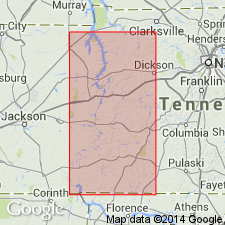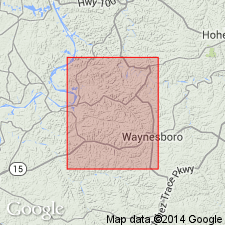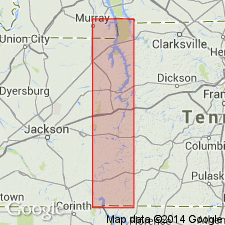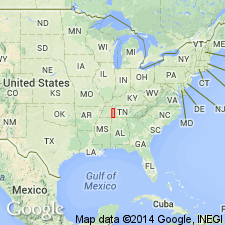
- Usage in publication:
-
- Bear Branch member
- Modifications:
-
- Original reference
- Dominant lithology:
-
- Limestone
- AAPG geologic province:
-
- Cincinnati arch
Summary:
Pg. 738. Bear Branch member of Olive Hill formation. Massive limestone and oolitic hematite to north; impure cherty limestone to south. Is more impure than overlying Flat Gap member, and is cross-bedded. Thickness 0 to 45 feet. Is middle member of Olive Hill formation, of Helderbergian age. Overlies Ross limestone member. Named for exposure on Bear Branch, about 2 miles southeast of Olive Hill, Hardin County, western Tennessee, where it forms low bluff showing 20 feet of low-grade ore resembling Clinton ore. Probably more or less = Pyburn limestone member of Olive Hill formation at Pyburns Bluff, on Tennessee River. [Age is Early Devonian (Helderbergian).]
Source: US geologic names lexicon (USGS Bull. 896, p. 132).

- Usage in publication:
-
- Bear Branch limestone member*
- Modifications:
-
- Overview
- AAPG geologic province:
-
- Cincinnati arch
Summary:
The Bear Branch limestone member of the Olive Hill formation is accepted for use by the USGS in Wayne Co., TN.
Source: GNU records (USGS DDS-6; Reston GNULEX).

- Usage in publication:
-
- Bear Branch Member
- Modifications:
-
- Revised
- AAPG geologic province:
-
- Cincinnati arch
Summary:
Bear Branch Member of Ross Formation previously considered facies of Ross Limestone Member (Wilson, 1949). Distinct lithology warrants recognition as separate member. Thickness at type is 11 m where it underlies Flat Gap Limestone. Lithology is variable, but unit is predominantly ferruginous to hematitic skeletal and oolitic grainstone. Locally cross-bedded. Deposited in local, high energy, but long-lived environment. Overlies Ross Limestone Member. Age is Early Devonian.
Source: GNU records (USGS DDS-6; Reston GNULEX).

- Usage in publication:
-
- Bear Branch facies
- Modifications:
-
- Revised
- AAPG geologic province:
-
- Cincinnati arch
Summary:
Unit is recognized in this report as a local hematitic facies of the Ross Limestone, but is not given formal member status. Wilson (1949) indicated the same relationship. Field investigation and analysis of Lower Devonian ostracode fauna indicate that the Birdsong Formation, the Rockhouse Formation, the "Rockhouse" Limestone, and the Ross Limestone represent facies of a single depositional episode.
Source: GNU records (USGS DDS-6; Reston GNULEX).
For more information, please contact Nancy Stamm, Geologic Names Committee Secretary.
Asterisk (*) indicates published by U.S. Geological Survey authors.
"No current usage" (†) implies that a name has been abandoned or has fallen into disuse. Former usage and, if known, replacement name given in parentheses ( ).
Slash (/) indicates name conflicts with nomenclatural guidelines (CSN, 1933; ACSN, 1961, 1970; NACSN, 1983, 2005, 2021). May be explained within brackets ([ ]).

